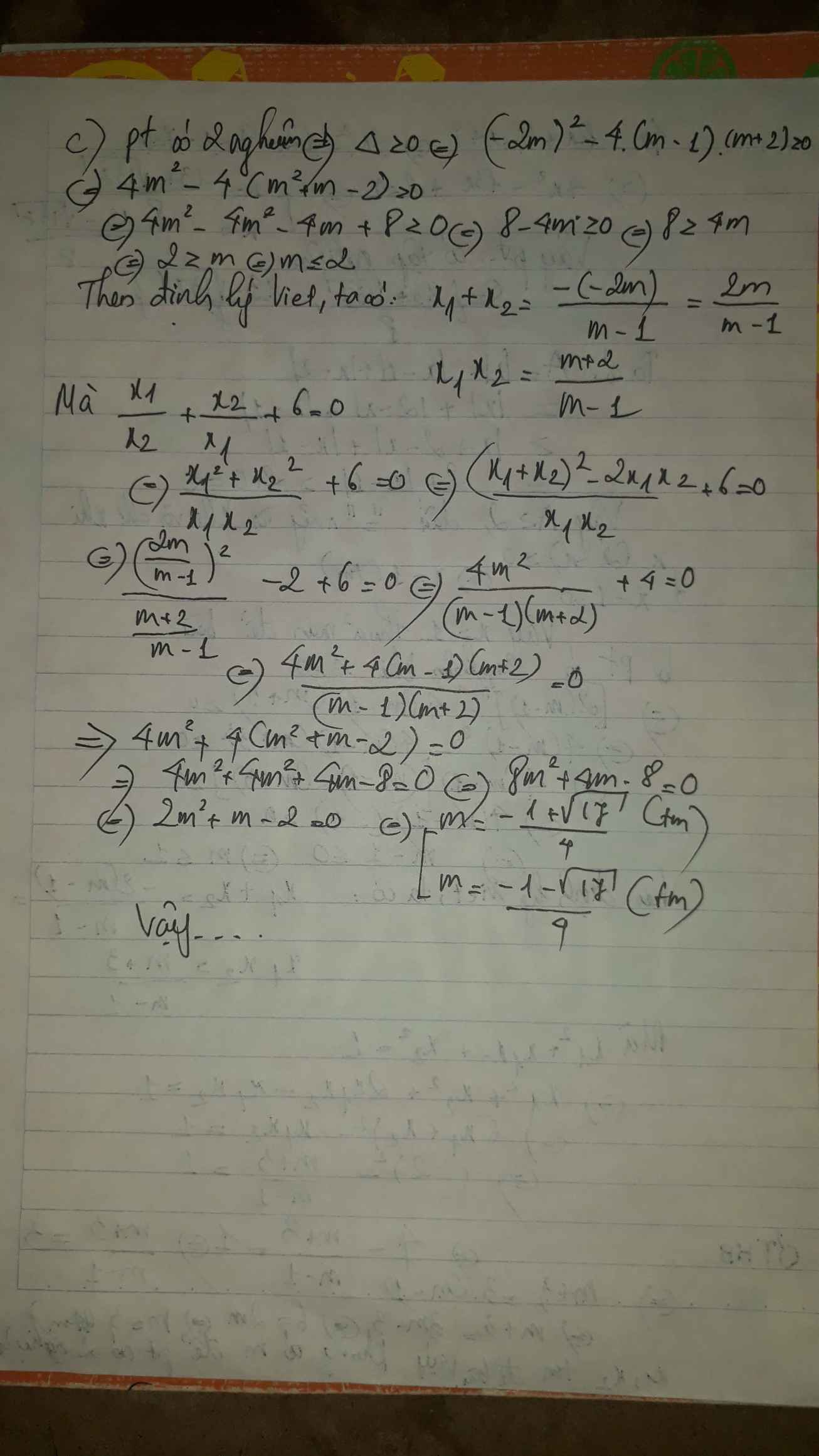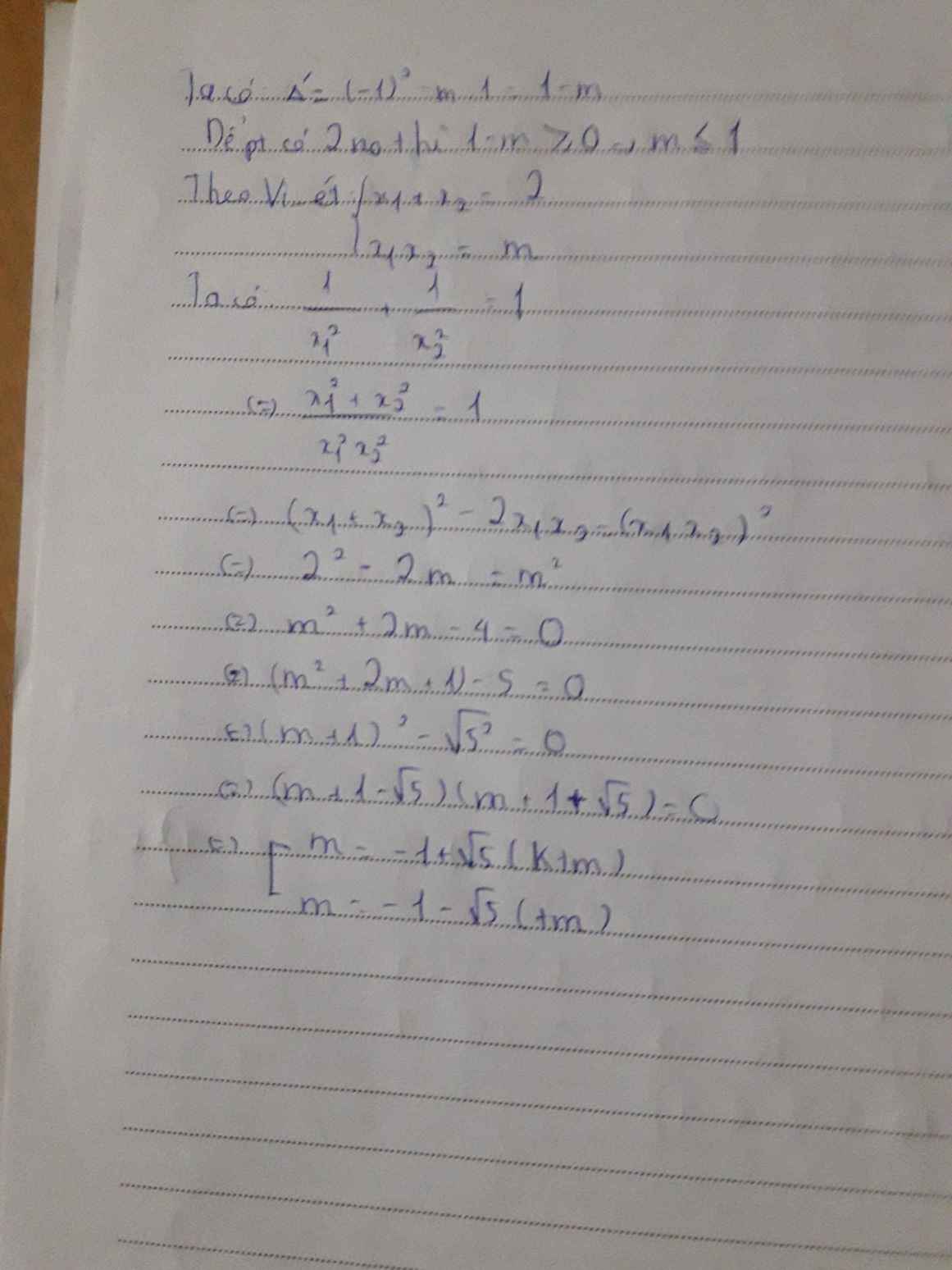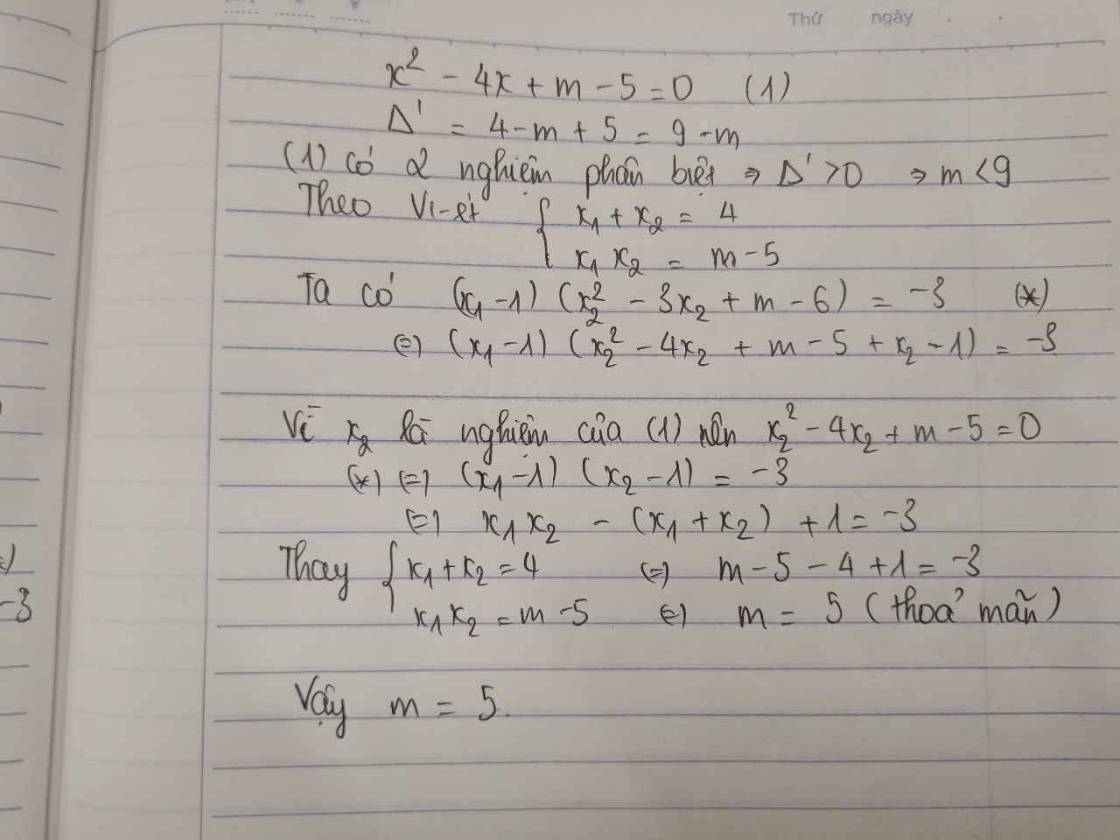Cho pt\(x^2-2\left(m+2\right)+m^2+m+3=0\)
Tìm m để pt có 2 nghiệm pb x1, x2 thỏa mãn : \(\dfrac{x_1}{x_2}+\dfrac{x_2}{x_1}=4\)

Những câu hỏi liên quan
Xác định m để pt có 2 nghiệm x1,x2 thỏa mãn ĐK kèm theo:
x2 - (m + 2)x + 2 = 0 ( \(\dfrac{x_1}{x_2}+\dfrac{x_2}{x_1}=\dfrac{9}{2}\))
Tìm giá trị của tham số m để pt x2 - 2(m+2)x + m2 + 4 = 0 có 2 nghiệm x1,x2 thỏa mãn hệ thức x1 + 2x2 = 7
Bước 1: Tìm điều kiện của tham số để phương trình có hai nghiệm phân biệt.
Bước 2: Khi phương trình đã có hai nghiệm phân biệt, ta áp dụng Vi-ét để tìm các giá trị của tham số.
Bước 3. Đối chiếu với điều kiện và kết luận bài toán.
xem tr sách của anh
Đúng 0
Bình luận (0)
Bài 1:
PT có 2 nghiệm \(\Leftrightarrow\Delta=\left(m+2\right)^2-4\cdot2\ge0\Leftrightarrow m^2+4m-8\ge0\Leftrightarrow\left[{}\begin{matrix}m\le-2-2\sqrt{3}\\m\ge-2+2\sqrt{3}\end{matrix}\right.\)
Áp dụng Viét: \(\left\{{}\begin{matrix}x_1+x_2=m+2\\x_1x_2=2\end{matrix}\right.\)
Ta có \(\dfrac{x_1}{x_2}+\dfrac{x_2}{x_1}=\dfrac{9}{2}\Leftrightarrow2\left(x_1^2+x_2^2\right)=9x_1x_2\)
\(\Leftrightarrow2\left[\left(x_1+x_2\right)^2-2x_1x_2\right]=18\\ \Leftrightarrow2\left(m+2\right)^2-8=18\\ \Leftrightarrow2m^2+8m+8-8=18\\ \Leftrightarrow m^2+4m-9=0\\ \Leftrightarrow\left[{}\begin{matrix}m=-2+\sqrt{13}\\m=-2-\sqrt{13}\end{matrix}\right.\left(tm\right)\)
Đúng 1
Bình luận (11)
b Tìm m để phương trình left(m-1right)x^2+2left(m-1right)x+m+30 có hai nghiệm x1,x2 thỏa mãn x_1^2+x_1.x_2+x_2^21c Tìm m để phương trình left(m-1right)x^2-2mx+m+20 có hai nghiệm x1,x2 phân biệt thỏa mãn dfrac{x_1}{x_2}+dfrac{x_2}{x_1}+60d Tìm m để phương trình 3x^2+4left(m-1right)x+m^2-4m+10 có hai nghiệm phân biệt x1,x2 thỏa mãn dfrac{1}{x_1}+dfrac{1}{x_2}dfrac{1}{2} (x1+x2)
Đọc tiếp
b Tìm m để phương trình \(\left(m-1\right)x^2+2\left(m-1\right)x+m+3=0\) có hai nghiệm x1,x2 thỏa mãn \(x_1^2+x_1.x_2+x_2^2=1\)
c Tìm m để phương trình \(\left(m-1\right)x^2-2mx+m+2=0\) có hai nghiệm x1,x2 phân biệt thỏa mãn \(\dfrac{x_1}{x_2}+\dfrac{x_2}{x_1}+6=0\)
d Tìm m để phương trình \(3x^2+4\left(m-1\right)x+m^2-4m+1=0\) có hai nghiệm phân biệt x1,x2 thỏa mãn \(\dfrac{1}{x_1}+\dfrac{1}{x_2}=\dfrac{1}{2}\) (x1+x2)
b) phương trình có 2 nghiệm \(\Leftrightarrow\Delta'\ge0\)
\(\Leftrightarrow\left(m-1\right)^2-\left(m-1\right)\left(m+3\right)\ge0\)
\(\Leftrightarrow m^2-2m+1-m^2-3m+m+3\ge0\)
\(\Leftrightarrow-4m+4\ge0\)
\(\Leftrightarrow m\le1\)
Ta có: \(x_1^2+x_1x_2+x_2^2=1\)
\(\Leftrightarrow\left(x_1+x_2\right)^2-2x_1x_2=1\)
Theo viet: \(\left\{{}\begin{matrix}x_1+x_2=-\dfrac{b}{a}=2\left(m-1\right)\\x_1x_2=\dfrac{c}{a}=m+3\end{matrix}\right.\)
\(\Leftrightarrow\left[-2\left(m-1\right)^2\right]-2\left(m+3\right)=1\)
\(\Leftrightarrow4m^2-8m+4-2m-6-1=0\)
\(\Leftrightarrow4m^2-10m-3=0\)
\(\Leftrightarrow\left[{}\begin{matrix}m_1=\dfrac{5+\sqrt{37}}{4}\left(ktm\right)\\m_2=\dfrac{5-\sqrt{37}}{4}\left(tm\right)\end{matrix}\right.\Rightarrow m=\dfrac{5-\sqrt{37}}{4}\)
Đúng 1
Bình luận (1)
Cho PT: x2 - 2(m+1)x + 2m - 3 = 0
Tìm các giá trị của m để PT có 2 nghiệm phân biệt x1, x2 thỏa mãn biểu thức \(P=\left|\dfrac{x_1+x_2}{x_1-x_2}\right|\) đạt giá trị nhỏ nhất.
Có\(\Delta=4\left(m+1\right)^2-4\left(2m-3\right)=4m^2+16>0\forall m\)
=> pt luôn có hai nghiệm pb
Theo viet có: \(\left\{{}\begin{matrix}x_1+x_2=2\left(m+1\right)\\x_1x_2=2m-3\end{matrix}\right.\)
Có :\(P^2=\left(\dfrac{x_1+x_2}{x_1-x_2}\right)^2=\dfrac{4\left(m+1\right)^2}{\left(x_1+x_2\right)^2-4x_1x_2}\)
\(=\dfrac{4\left(m+1\right)^2}{4\left(m+1\right)^2-4\left(2m-3\right)}=\dfrac{4\left(m+1\right)^2}{4m^2+16}\)\(\ge0\)
\(\Rightarrow P\ge0\)
Dấu = xảy ra khi m=-1
Đúng 2
Bình luận (0)
Cho ptr :\(x^2-2\left(m-1\right)x+m+1=0\)
Tìm m để ptr trên có 2 nghiệm x1,x2 thỏa mãn \(\dfrac{x_1}{x_2}+\dfrac{x_2}{x_1}=4\)
Δ=(2m-2)^2-4(m+1)
=4m^2-8m+4-4m-4
=4m^2-12m
Để phương trình co hai nghiệm thì 4m^2-12m>0
=>m>3 hoặc m<0
x1/x2+x2/x1=4
=>x1^2+x2^2=4x1x2
=>(x1+x2)^2-2x1x2=4x1x2
=>(2m-2)^2-6(m+1)=0
=>4m^2-8m+4-6m-6=0
=>4m^2-14m-2=0
=>\(m=\dfrac{7\pm\sqrt{57}}{2}\)
Đúng 1
Bình luận (0)
cho pt: \(x^2-2x+m=0\)
tìm m để pt có 2 nghiệm x1, x2 thỏa mãn \(\dfrac{1}{x_1^2}+\dfrac{1}{x_2^2}=1\)
Phương trình có nghiệm \(\Leftrightarrow\Delta'\ge0\Leftrightarrow1-m\ge0\Leftrightarrow m\le1\)
Theo hệ thức Vi-ét: \(\left\{{}\begin{matrix}x_1+x_2=2\\x_1x_2=m\end{matrix}\right.\) (1)
Ta có: \(\dfrac{1}{x^2}+\dfrac{1}{x^2}=1\Leftrightarrow\dfrac{x^2_1+x^2_2}{x^2_1x^2_2}=1\Leftrightarrow\dfrac{\left(x_1+x_2\right)^2-2x_1x_2}{\left(x_1x_2\right)^2}=1\) (2)
Từ (1) và (2) \(\Rightarrow4-2m=m^2\Leftrightarrow m^2+2m-4=0\)
\(\Delta'=1+4=5\Rightarrow\sqrt{\Delta'}=\sqrt{5}\Rightarrow\left[{}\begin{matrix}m=-1+\sqrt{5}\left(\text{loại}\right)\\m=-1-\sqrt{5}\left(\text{nhận}\right)\end{matrix}\right.\)
Vậy \(m=-1-\sqrt{5}\)
Đúng 1
Bình luận (0)
cho phương trình x2-2(m-1)x-3=0
tìm m để pt trên có 2 nghiệm phân biệt x1 , x2 thỏa mãn\(\dfrac{x_1}{x_2^2}+\dfrac{x_2}{x_1^2}=m-1\)
Xét \(\Delta=4\left(m-1\right)^2-4.\left(-3\right)=4\left(m-1\right)^2+12>0\forall m\)
=>Pt luôn có hai nghiệm pb
Theo viet:\(\left\{{}\begin{matrix}x_1+x_2=2\left(m-1\right)\\x_1.x_2=-3\ne0\forall m\end{matrix}\right.\)
Có \(\dfrac{x_1}{x_2^2}+\dfrac{x_2}{x_1^2}=m-1\)
\(\Leftrightarrow x_1^3+x_2^3=\left(m-1\right)x_1^2.x_2^2\)
\(\Leftrightarrow\left(x_1+x_2\right)^3-3x_1x_2\left(x_1+x_2\right)=\left(m-1\right).\left(-3\right)^2\)
\(\Leftrightarrow8\left(m-1\right)^3-3\left(-3\right).2\left(m-1\right)=9\left(m-1\right)\)
\(\Leftrightarrow8\left(m-1\right)^3+9\left(m-1\right)=0\)
\(\Leftrightarrow\left(m-1\right)\left[8\left(m-1\right)^2+9\right]=0\)
\(\Leftrightarrow m=1\)(do \(8\left(m-1\right)^2+9>0\) với mọi m)
Vậy m=1
Đúng 2
Bình luận (0)
Vì \(ac< 0\) \(\Rightarrow\) Phương trình luôn có 2 nghiệm phân biệt
Theo Vi-ét, ta có: \(\left\{{}\begin{matrix}x_1+x_2=2m-2\\x_1x_2=-3\end{matrix}\right.\)
Mặt khác: \(\dfrac{x_1}{x_2^2}+\dfrac{x_2}{x_1^2}=m-1\) \(\Rightarrow\dfrac{\left(x_1+x_2\right)\left(x_1^2+x_2^2-x_1x_2\right)}{x_1^2x_2^2}=m-1\)
\(\Leftrightarrow\dfrac{\left(x_1+x_2\right)\left[\left(x_1+x_2\right)^2-3x_1x_2\right]}{x_1^2x_2^2}=m-1\)
\(\Rightarrow\dfrac{\left(2m-2\right)\left(4m^2-8m+13\right)}{9}=m-1\)
\(\Leftrightarrow...\)
Đúng 0
Bình luận (0)
bài 10:
Cho pt x2+5x+m-2=0
Tìm m để pt có 2 nghiệm pb thỏa mãn \(\dfrac{1}{x_1-1}+\dfrac{1}{x_2-1}=2\)
Lời giải:
Để pt có 2 nghiệm thì: $\Delta=25-4(m-2)\geq 0$
$\Leftrightarrow m\leq \frac{33}{4}$
Áp dụng hệ thức Viet, với $x_1,x_2$ là 2 nghiệm của pt thì:
$x_1+x_2=-5$
$x_1x_2=m-2$
Khi đó:
$\frac{1}{x_1-1}+\frac{1}{x_2-1}=2$
$\Leftrightarrow \frac{x_1+x_2-2}{(x_1-1)(x_2-1)}=2$
$\Leftrightarrow \frac{-5-2}{(x_1-1)(x_2-1)}=2$
$\Leftrightarrow (x_1-1)(x_2-1)=\frac{-7}{2}$
$\Leftrightarrow x_1x_2-(x_1+x_2)+1=\frac{-7}{2}$
$\Leftrightarrow m-2+5+1=\frac{-7}{2}$
$\Leftrightarrow m=\frac{-15}{2}$ (tm)
Đúng 2
Bình luận (0)
Lời giải:
Để pt có 2 nghiệm thì: $\Delta=25-4(m-2)\geq 0$
$\Leftrightarrow m\leq \frac{33}{4}$
Áp dụng hệ thức Viet, với $x_1,x_2$ là 2 nghiệm của pt thì:
$x_1+x_2=-5$
$x_1x_2=m-2$
Khi đó:
$\frac{1}{x_1-1}+\frac{1}{x_2-1}=2$
$\Leftrightarrow \frac{x_1+x_2-2}{(x_1-1)(x_2-1)}=2$
$\Leftrightarrow \frac{-5-2}{(x_1-1)(x_2-1)}=2$
$\Leftrightarrow (x_1-1)(x_2-1)=\frac{-7}{2}$
$\Leftrightarrow x_1x_2-(x_1+x_2)+1=\frac{-7}{2}$
$\Leftrightarrow m-2+5+1=\frac{-7}{2}$
$\Leftrightarrow m=\frac{-15}{2}$ (tm)
Đúng 2
Bình luận (0)
1 . Cho pt :x^2-mx+m-10 . Tìm m để pt có 2 nghiệm x_1,x_2 và biểu thức Adfrac{2x_1x_2+3}{x^2_1+x^2_2+2left(x_1x_2+1right)} đạt GTLN2.Giả sử m là giá trị để phương trình x^2-mx+m-20 có 2 nghiệm x_1,x_2 thỏa mãn dfrac{x_1^{^2}-2}{x_1-1}.dfrac{x^2_2-2}{x_2-1}4 . Tìm các giá trị của m
Đọc tiếp
1 . Cho pt :\(x^2-mx+m-1=0\) . Tìm m để pt có 2 nghiệm \(x_1,x_2\) và biểu thức \(A=\dfrac{2x_1x_2+3}{x^2_1+x^2_2+2\left(x_1x_2+1\right)}\) đạt GTLN
2.Giả sử m là giá trị để phương trình \(x^2-mx+m-2=0\) có 2 nghiệm \(x_1,x_2\) thỏa mãn \(\dfrac{x_1^{^2}-2}{x_1-1}.\dfrac{x^2_2-2}{x_2-1}=4\) . Tìm các giá trị của m
1.
\(a+b+c=0\) nên pt luôn có 2 nghiệm
\(\left\{{}\begin{matrix}x_1+x_2=m\\x_1x_2=m-1\end{matrix}\right.\)
\(A=\dfrac{2x_1x_2+3}{x_1^2+x_2^2+2x_1x_2+2}=\dfrac{2x_1x_2+3}{\left(x_1+x_2\right)^2+2}=\dfrac{2\left(m-1\right)+3}{m^2+2}=\dfrac{2m+1}{m^2+2}\)
\(A=\dfrac{m^2+2-\left(m^2-2m+1\right)}{m^2+2}=1-\dfrac{\left(m-1\right)^2}{m^2+2}\le1\)
Dấu "=" xảy ra khi \(m=1\)
2.
\(\Delta=m^2-4\left(m-2\right)=\left(m-2\right)^2+4>0;\forall m\) nên pt luôn có 2 nghiệm pb
Theo Viet: \(\left\{{}\begin{matrix}x_1+x_2=m\\x_1x_2=m-2\end{matrix}\right.\)
\(\dfrac{\left(x_1^2-2\right)\left(x_2^2-2\right)}{\left(x_1-1\right)\left(x_2-1\right)}=4\Rightarrow\dfrac{\left(x_1x_2\right)^2-2\left(x_1^2+x_2^2\right)+4}{x_1x_2-\left(x_1+x_2\right)+1}=4\)
\(\Rightarrow\dfrac{\left(x_1x_2\right)^2-2\left(x_1+x_2\right)^2+4x_1x_2+4}{x_1x_2-\left(x_1+x_2\right)+1}=4\)
\(\Rightarrow\dfrac{\left(m-2\right)^2-2m^2+4\left(m-2\right)+4}{m-2-m+1}=4\)
\(\Rightarrow-m^2=-4\Rightarrow m=\pm2\)
Đúng 1
Bình luận (2)
9.2
cho `x^2 -4x+m-5=0`
tìm m để pt có 2 nghiệm pb `x_1 ;x_2` thỏa mãn \(\left(x_1-1\right)\left(x_2^2-3x_2+m-6\right)=-3\)
Cho pt ẩn x : x2 - 5x + m - 2 = 0 (1)
a) Giải pt (1) khi m = -4
b) Tìm m để pt có 2 nghiệm dương phân biệt x1 , x2 thoả mãn hệ thức:
\(2\left(\dfrac{1}{\sqrt{x_1}}+\dfrac{1}{\sqrt{x_2}}\right)=3\)
a: Khi m = -4 thì:
\(x^2-5x+\left(-4\right)-2=0\)
\(\Leftrightarrow x^2-5x-6=0\)
\(\Delta=\left(-5\right)^2-5\cdot1\cdot\left(-6\right)=49\Rightarrow\sqrt{\Delta}=\sqrt{49}=7>0\)
Pt có 2 nghiệm phân biệt:
\(x_1=\dfrac{5+7}{2}=6;x_2=\dfrac{5-7}{2}=-1\)
Đúng 2
Bình luận (1)
b: \(\Delta=\left(-5\right)^2-4\left(m-2\right)=25-4m+8=33-4m\)
Theo viet:
\(x_1+x_2=-\dfrac{b}{a}=5\)
\(x_1x_2=\dfrac{c}{a}=m-2\)
Để pt có 2 nghiệm dương phân biệt:
\(\Leftrightarrow\left\{{}\begin{matrix}\Delta>0\\x_1+x_2>0\\x_1x_2>0\end{matrix}\right.\Leftrightarrow\left\{{}\begin{matrix}33-4m>0\\5>0\left(TM\right)\\m-2>0\end{matrix}\right.\Leftrightarrow\left\{{}\begin{matrix}m< \dfrac{33}{4}\\x>2\end{matrix}\right.\Leftrightarrow m=2< m< \dfrac{33}{4}\)
Vậy \(2< m< \dfrac{33}{4}\) thì pt có 2 nghiệm dương phân biệt.
Theo đầu bài: \(\dfrac{1}{\sqrt{x_1}}+\dfrac{1}{\sqrt{x_2}}=\dfrac{3}{2}\)
\(\Leftrightarrow\sqrt{x_1}+\sqrt{x_2}=\dfrac{3}{2}\left(\sqrt{x_1x_2}\right)\)
\(\Leftrightarrow\left(\sqrt{x_1}+\sqrt{x_2}\right)^2=\dfrac{9}{4}x_1x_2\)
\(\Leftrightarrow x_1+2\sqrt{x_1x_2}+x_2=\dfrac{9}{4}x_1x_2\)
\(\Leftrightarrow x_1+x_2+2\sqrt{x_1x_2}=\dfrac{9}{4}x_1x_2\)
\(\Leftrightarrow5+2\sqrt{x_1x_2}=\dfrac{9}{4}\left(m-2\right)\)
\(\Leftrightarrow\dfrac{9}{4}\left(m-2\right)-2\sqrt{m-2}-5=0\)
Đặt \(\sqrt{m-2}=t\Rightarrow m-2=t^2\)
\(\Rightarrow\dfrac{9}{4}t^2-2t-5=0\)
\(\Leftrightarrow\dfrac{9}{4}t^2-2+\left(-5\right)=0\)
\(\Leftrightarrow\left(t-2\right)\left(9t+10\right)=0\)
\(\Leftrightarrow\left[{}\begin{matrix}t-2=0\\9t+10=0\end{matrix}\right.\Leftrightarrow\left[{}\begin{matrix}t=2\left(TM\right)\\t=-\dfrac{10}{9}\left(\text{loại}\right)\end{matrix}\right.\)
Trả ẩn:
\(\sqrt{m-2}=2\)
\(\Rightarrow m-2=4\)
\(\Rightarrow m=6\)
Vậy m = 6 thì x1 , x2 thoả mãn hệ thức \(2\left(\dfrac{1}{\sqrt{x_1}}+\dfrac{1}{\sqrt{x_2}}\right)=\dfrac{3}{2}\).
Đúng 2
Bình luận (1)




































